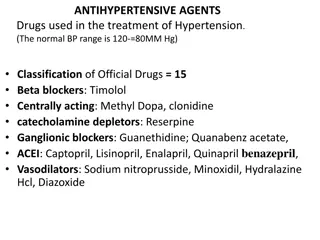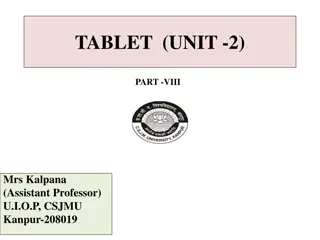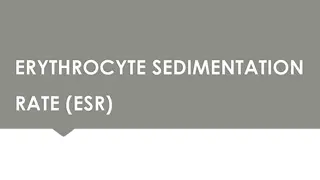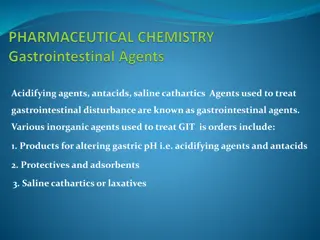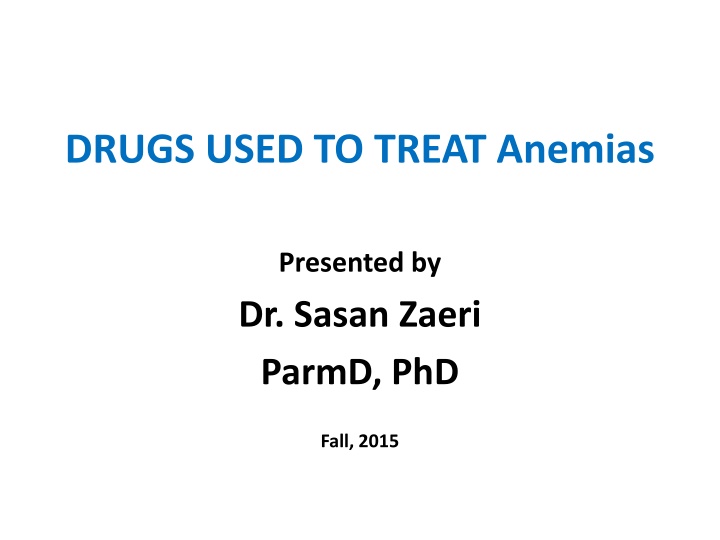
Agents Used in Anemia Treatment
Explore the key agents used in treating anemias, such as iron, vitamin B12, folic acid, and hematopoietic growth factors. Learn about the pharmacokinetics of iron absorption, transport, and storage in the body to support hematopoiesis.
Download Presentation

Please find below an Image/Link to download the presentation.
The content on the website is provided AS IS for your information and personal use only. It may not be sold, licensed, or shared on other websites without obtaining consent from the author. If you encounter any issues during the download, it is possible that the publisher has removed the file from their server.
You are allowed to download the files provided on this website for personal or commercial use, subject to the condition that they are used lawfully. All files are the property of their respective owners.
The content on the website is provided AS IS for your information and personal use only. It may not be sold, licensed, or shared on other websites without obtaining consent from the author.
E N D
Presentation Transcript
DRUGS USED TO TREAT Anemias Presented by Dr. Sasan Zaeri ParmD, PhD Fall, 2015
Agents Used in Anemias Hematopoiesis: the production from undifferentiated stem cells of circulating erythrocytes, platelets, and leukocytes Essential factors: Iron, vitamin B12, folic acid and hematopoietic growth factors Inadequate supply results in: Anemia, thrombocytopenia and neutropenia 2
AGENTS USED IN ANEMIAS: IRON Iron deficiency the most common cause of chronic anemia leads to pallor, fatigue, dizziness, exertional dyspnea, etc. small erythrocytes with insufficient hemoglobin are formed >>> microcytic hypochromic anemia 3
Pharmacokinetics Elaborate system for regulating iron (figure) Iron sources to support hematopoiesis: catalysis of the hemoglobin in senescent or damaged erythrocytes dietary iron from a wide variety of foods iron requirements can exceed normal dietary supplies in growing children and pregnant women (increased iron requirements) menstruating women (increased losses of iron) 4
Pharmacokinetics ABSORPTION 0.5-1 mg/d iron from food by a normal individual 1-2 mg/d in normal menstruating women 3-4 mg/d in pregnant women The iron in meat (heme iron) can be efficiently absorbed Nonheme iron in foods must be reduced to ferrous iron (Fe2+) before it can be absorbed 5
Pharmacokinetics TRANSPORT Iron is transported in the plasma bound to transferrin The transferrin-iron complex enters maturing erythroid cells by receptor-mediated endocytosis iron deficiency anemia is associated with an increased concentration of serum transferrin 6
Pharmacokinetics STORAGE primarily as ferritin in intestinal mucosal cells, macrophages in the liver, spleen, and bone and in parenchymal liver cells the serum ferritin level can be used to estimate total body iron stores Apoferritin (precursor of ferritin) levels is regulated by the levels of free iron free iron apoferritin iron binding to transferrin free iron apoferritin protection of organs from the iron toxic effects 7
Pharmacokinetics ELIMINATION no mechanism for excretion of iron: regulation of iron balance must be achieved by changing intestinal absorption and storage of iron, in response to the body's needs 8
Clinical Pharmacology The only clinical indication: treatment or prevention of iron deficiency anemia Patients with increased iron requirements: infants, especially premature infants children during rapid growth periods pregnant and lactating women patients with chronic kidney disease Loss of erythrocytes at a relatively high rate during hemodialysis Erythrocyte production at a high rate as a result of treatment with erythropoietin Patients with iron malabsorption: Patients after gastrectomy patients with severe small bowel disease that results in generalized malabsorption 9
Clinical Pharmacology The most common cause of iron deficiency in adults: blood loss Menstruating women lose about 30 mg of iron with each menstrual period many premenopausal women have low iron stores or even iron deficiency In men and postmenopausal women, the most common site of blood loss is the gastrointestinal tract 10
Clinical Pharmacology TREATMENT with oral or parenteral iron preparations Oral iron corrects the anemia just as rapidly and completely as parenteral iron in most cases if iron absorption from the gastrointestinal tract is normal for patients with advanced chronic kidney disease who are undergoing hemodialysis and treatment with erythropoietin, parenteral iron administration is preferred 11
Clinical Pharmacology Oral iron therapy Only ferrous salts should be used Ferrous sulfate, ferrous gluconate and ferrous fumarate Different iron salts provide different amounts of elemental iron Ferrous fumarate> Ferrous sulfate>ferrous gluconate 200-400 mg/d of elemental iron corrects iron deficiency most rapidly 12
Clinical Pharmacology Oral iron therapy lower daily doses can be given: slower but still complete correction of iron deficiency Treatment should be continued for 3-6 months after correction of the cause of the iron loss This corrects the anemia and replenishes iron stores 13
Clinical Pharmacology Oral iron therapy Common adverse effects: nausea, epigastric discomfort, abdominal cramps, constipation, and diarrhea Adverse effects can often be overcome by lowering the daily dose of iron taking the tablets immediately after or with meals Changing from one iron salt to another Patients taking oral iron develop black stools This may obscure the diagnosis of continued gastrointestinal blood loss 14
Clinical Pharmacology Parenteral iron therapy Parenteral therapy should be reserved for patients unable to tolerate or absorb oral iron patients with various postgastrectomy conditions patients with previous small bowel resection inflammatory bowel disease malabsorption syndromes patients with extensive chronic blood loss who cannot be maintained with oral iron alone: advanced chronic renal disease including hemodialysis and treatment with erythropoietin 15
Clinical Pharmacology Parenteral iron therapy Iron-dextran deep IM injection or IV infusion the IV route is used most commonly Adverse effects of IV route: headache, light-headedness, fever, arthralgias, nausea and vomiting, back pain, flushing, urticaria, bronchospasm, and, rarely, anaphylaxis and death a small test dose should always be given before full IM or IV doses are given 16
Clinical Pharmacology Parenteral iron therapy Alternative preparations to iron-dextran: Iron- sucrose and iron-gluconate Can be given only by IM route Less likely than iron dextran to cause hypersensitivity reactions 17
Clinical Toxicity ACUTE IRON TOXICITY Seen almost exclusively in young children who accidentally ingest iron tablets Even 10 tablets can be lethal in young children Adult patients should be instructed to store tablets out of the reach of children Manifestations: necrotizing gastroenteritis Vomiting abdominal pain bloody diarrhea Severe metabolic acidosis Coma and death 18
Clinical Toxicity ACUTE IRON TOXICITY Urgent treatment is necessary Whole bowel irrigation should be performed Deferoxamine, a potent iron-chelating compound, can be given systemically to bind iron that has already been absorbed and to promote its excretion in urine and feces Activated charcoal does not bind iron and thus is ineffective Appropriate supportive therapy for gastrointestinal bleeding, metabolic acidosis, and shock must also be provided 19
Clinical Toxicity CHRONIC IRON TOXICITY Also known as iron overload or hemochromatosis excess iron is deposited in the heart, liver, pancreas, and other organs It can lead to organ failure and death occurs in patients with inherited hemochromatosis (a disorder characterized by excessive iron absorption) patients who receive many red cell transfusions over a long period of time (e.g. patients with thalassemia major) 20
Clinical Toxicity CHRONIC IRON TOXICITY In the absence of anemia is treated by intermittent phlebotomy parenteral deferoxamine is much less efficient deferoxamine can be the only option for iron overload in patients with thalassemia major deferasirox (oral iron chelator) has been approved for treatment of iron overload Deferasirox appears to be as effective as deferoxamine at reducing liver iron concentrations and is much more convenient 21
AGENTS USED IN ANEMIAS: Vitamin B12 Vitamin B12 serves as a cofactor for several essential biochemical reactions in humans Deficiency of vitamin B12 leads to anemia gastrointestinal symptoms neurologic abnormalities Most common cause of B12 deficiency: inadequate absorption of dietary vitamin B12 especially in older adults Active forms of the vitamin in humans: Deoxyadenosylcobalamin Methylcobalamin 22
VITAMIN B12 Inactive forms of the vitamin: Cyanocobalamin (available for therapeutic use) Hydroxocobalamin (available for therapeutic use) Other cobalamins found in food sources The chief dietary source of vitamin B12 : Meat, liver, eggs and dairy products Vitamin B12 is sometimes called extrinsic factor to differentiate it from intrinsic factor 23
Pharmacokinetics Vitamin B12 is avidly stored in the liver with an average total storage pool of 3000-5000 mcg (Lasting for 5 years) Vitamin B12 is absorbed only after it complexes with intrinsic factor secreted by the parietal cells of the gastric mucosa intrinsic factor-vitamin B12 complex is subsequently absorbed in the distal ileum Vitamin B12 deficiency results from malabsorption of vitamin B12 due to lack of intrinsic factor loss or malfunction of the specific absorptive mechanism in the distal ileum Vitamin B12 is transported to the various cells of the body bound to a plasma glycoprotein, transcobalamin II 24
Pharmacodynamics Methylcobalamin converts N5- methyltetrahydrofolate to tetrahydrofolate (figure) N5-methyltetrahydrofolate: major dietary and storage folate Tetrahydrofolate: precursor of folate cofactors Vitamin B12 Tetrahydrofolate folate cofactors dTMP and purines and DNA in rapidly dividing cells 25
Pharmacodynamics Methylfolate trap: The accumulation of folate as N5- methyltetrahydrofolate and the associated depletion of tetrahydrofolate cofactors in vitamin B12 deficiency Folic acid can be reduced to dihydrofolate and tetrahydrofolate by the enzyme dihydrofolate reductase (figure) this explains why the megaloblastic anemia of vitamin B12 deficiency can be partially corrected by ingestion of relatively large amounts of folic acid 26
Pharmacodynamics Other enzymatic reaction that requires vitamin B12 : isomerization of methylmalonyl-CoA to succinyl-CoA Vitamin B12 deficiency causes neurologic damage via: methylmalonyl-CoA or methionine Administration of folic acid in the setting of vitamin B12 deficiency will not prevent neurologic manifestations 27
Clinical Pharmacology Vitamin B12 deficiency manifestations: megaloblastic anemia (most characteristic clinical manifestation) The neurologic syndrome paresthesias, weakness ,ataxia, other central nervous system dysfunctions Correction of vitamin B12 deficiency arrests the progression of neurologic disease, but it may not fully reverse neurologic symptoms that have been present for several months 28
Clinical Pharmacology Upon diagnosis of megaloblastic anemia: it must be determined whether vitamin B12 or folic acid deficiency is the cause This can usually be accomplished by measuring serum levels of the vitamins 29
Clinical Pharmacology The most common causes of vitamin B12 deficiency: pernicious anemia partial or total gastrectomy conditions that affect the distal ileum Pernicious anemia results from defective secretion of intrinsic factor by the gastric mucosal cells 30
Clinical Pharmacology Treatment of vitamin B12 deficiency Parenteral injections of vitamin B12 are required for therapy Vitamin B12 for parenteral injection is available as cyanocobalamin or hydroxocobalamin Hydroxocobalamin is preferred because it is more highly protein-bound Initial therapy: 100-1000 mcg of vitamin B12 IM daily or every other day for 1-2 weeks to replenish body stores Maintenance therapy: 100-1000 mcg IM once a month for life 31
AGENTS USED IN ANEMIAS: FOLIC ACID Reduced forms of folic acid are required for synthesis of amino acids, purines, and DNA The consequences of folate deficiency: Anemia congenital malformations in newborns 32
Pharmacokinetics The richest sources of folic acid: yeast, liver, kidney and green vegetables Body stores of folates are relatively low and daily requirements high folic acid deficiency and megaloblastic anemia can develop within 1-6 months after the intake of folic acid stops 33
Clinical Pharmacology Folate deficiency results in a megaloblastic anemia that is indistinguishable from the anemia caused by vitamin B12 deficiency folate deficiency does not cause the characteristic neurologic syndrome seen in vitamin B12 deficiency 34
Clinical Pharmacology Causes of folic acid deficiency inadequate dietary intake of folates alcohol dependence liver diseases (diminished hepatic storage of folates) Pregnancy maternal folic acid deficiency may cause fetal neural tube defects e.g. spina bifida hemolytic anemia 35
Clinical Pharmacology Causes of folic acid deficiency renal dialysis (folate loss during dialysis) Drugs Methotrexate, trimethoprim and pyrimethamine Leading to megaloblastic anemia Long-term therapy with phenytoin Rarely leading to megaloblastic anemia 36
Clinical Pharmacology Treatment of folic acid deficiency: 1 mg/d folic acid orally reverses megaloblastic anemia restore normal serum folate levels replenishes body stores of folates Therapy should be continued until the underlying cause of the deficiency is removed or corrected Folic acid supplementation to prevent folic acid deficiency should be considered in high-risk patients: pregnant women, patients with alcohol dependence, hemolytic anemia, liver disease, or certain skin diseases, and patients on renal dialysis 37


